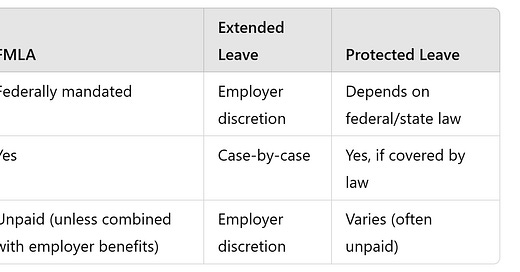When employees need time off for personal or medical reasons, terms like FMLA, extended, and protected leave often arise. While these concepts are interconnected, they serve different purposes and have distinct legal and practical implications. Here’s a breakdown to help navigate these types of leave.
1. Family and Medical Leave Act (FMLA)
FMLA is a federal law that provides job-protected, unpaid leave for up to 12 weeks in a 12-month period. It applies to:
Eligibility: Employees who have worked for your company for at least 12 months, have logged 1,250 hours in the past year, and work at a location with 50+ employees within a 75-mile radius.
Reasons for Leave: Includes personal or family medical conditions, childbirth or adoption, or caring for a seriously ill family member.
While FMLA ensures job protection, it does not require employers to pay wages during this time. Some employers choose to offer paid leave concurrently with FMLA.
2. Extended Leave
Extended leave refers to time off beyond what’s typically provided by FMLA or standard leave policies. Unlike FMLA, extended leave is not a legal requirement unless it overlaps with other protected leave laws (e.g., the Americans with Disabilities Act or state laws).
Policy-Based: Employers may create extended leave policies, often as an employee benefit.
Flexibility: These leaves are negotiated case-by-case and may or may not include job protection.
Duration: The length of extended leave is typically at the employer’s discretion unless otherwise mandated by local or state laws.
3. Protected Leave
Protected leave is an umbrella term that ensures an employee’s job is secure while on leave. FMLA is one example of protected leave, but it’s not the only one. Other types of protected leave include:
Pregnancy leave: Covered under various federal and state laws.
Disability leave: Governed by the ADA, which may require employers to accommodate extended leave as a reasonable adjustment.
State and Local Laws: Some states offer paid sick leave, family leave, or additional protections beyond federal regulations.
The key element of protected leave is that employees cannot be terminated, demoted, or retaliated against for taking leave covered by law.
Key Differences at a Glance:
The Bottom Line
Understanding the differences between FMLA, extended leave, and protected leave is crucial for creating fair and compliant leave policies. Review federal, state, and local laws to ensure your policies meet legal requirements. When in doubt, consult an HR professional to support your employees and your business effectively.





